|
The Human Brain Research Group (HBRG) was organized at the Department of Human and Animal Physiology, M.V.Lomonosov Moscow State University (Faculty of Biology) for carrying out basic scientific and applied projects in the area of studying human brain functional states underlying mental functions in normal and abnormal conditions.
The founder and head of the HBRG is one of the Department's leading research scientists Professor Alexander Ya. Kaplan.
More about our BCI research (in Russian)
|
Research topics
Application of approaches, techniques and software developed by the group in other laboratories:
- Evgeniy Verevkin, Dmitriy Putilov, Olga Donskaya, Arcady Putilov. A new SWPAQ's scale predicts the effects of sleep deprivation on the segmental structure of alpha waves. Biological Rhythm Research. 2008;39(1):21-37. [ informaworld ]
- D.A.Putilov, E.G.Verevkin, O.G.Donskaya and A.A.Putilov. Segmental structure of alpha waves in sleep-deprived subjects. Somnologie - Schlafforschung und Schlafmedizin. 2007;11(3):202-210. [ SpringerLink ]
See also:
|
|
|
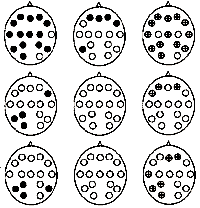 |
1. Search for electroencephalographic (EEG) markers of adverse states of human brain, which occur during intensive intellectual work requiring increased involvement of working memory, attention, thinking and voluntary control. The studies are carried out:
- in real life working conditions in professional industrial operators, such as dispatchers of thermal and nuclear power plants
- in laboratory conditions, using computer simulation of operator tasks
- A.Ya.Kaplan. Homo anxius: in a search for harmony. Proceedings of the 7th Interdisciplinar Symposium "Psychophysiology of Stress". Moscow (Russia) 26-28 February 2003. Moscow, 2003. P. 29-32. (In Russian) [ PDF ]
- A.Ya.Kaplan, S.V.Borisov. Dynamic properties of segmental characteristics of EEG alpha activity in rest conditions and during cognitive tasks. Zh. Vyssh. Nerv. Deiat. Im. I.P.Pavlova. 2003;53(1):22-32. [ PubMed ]
- A.Fingelkurts, A.Fingelkurts, C.Krause, A.Kaplan, S.Borisov, M.Sams. Structural (operational) synchrony of EEG alpha activity during an auditory memory task. Neuroimage. 2003;20(1):529-542. [ PDF ]
- P.Landa, A.Kaplan, E.Zhukovskaya. A model for the speed of memory retrieval. Biol. Cybern. 2003;89(4):313-316. [ PDF ]
up |
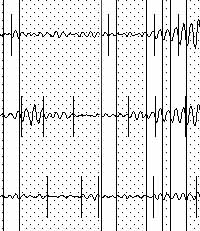 | 2. Designing new algorithms and methods for segmentation based electroencephalogram (EEG) analysis, computing new quantitative EEG estimates. Up to date, the following methods have been implemented:
- nonparametric EEG segmentation (programs Verdia, SECTION01®, SCAN0.1®)
- adaptive classification of spectral patterns (ACSPAT0.1)
The Human Brain Research Group demonstrated the existence of the new type of cooperation between brain structures, presented as structural synchrony (a term proposed by the group) at the level of EEG.
For studying structural synchrony, the group developed a special methodology, which was, to a large extent, implemented in program JumpSyn0.1®.
- A.Fingelkurts, A.Fingelkurts, C.Krause, A.Kaplan, S.Borisov, M.Sams. Structural (operational) synchrony of EEG alpha activity during an auditory memory task. Neuroimage. 2003;20(1):529-542. [ PDF ]
- A.Ya.Kaplan, S.V.Borisov. Dynamic properties of segmental characteristics of EEG alpha activity in rest conditions and during cognitive tasks. Zh. Vyssh. Nerv. Deiat. Im. I.P.Pavlova. 2003;53(1):22-32. [ PubMed ]
- Al.A.Fingelkurts, An.A.Fingelkurts, C.M.Krause, A.Ya.Kaplan. Systematic rules underlining spectral pattern variability: experimental results and a review of the evidence. Int. J. Neurosci. 2003;113(10):1447-1473. [ PDF ]
- Al.A.Fingelkurts, An.A.Fingelkurts, A.Ya.Kaplan. The regularities of the discrete nature of multi-variability of EEG spectral patterns. Int. J. Psychophysiol. 2003;47(1):23-41. [ PDF ]
- A.Ya.Kaplan, S.V.Borisov, S.L.Shishkin, V.A.Ermolaev. Analysis of the segmental structure of EEG alpha-activity in humans. Ross Fiziol Zh Im I M Sechenova. 2002;4:84-95. (In Russian) [ PDF ]
- A.Ya.Kaplan, S.L.Shishkin. Application of the change-point analysis to the investigation of the brain electrical activity. Chapter 7 in: B.E.Brodsky, B.S.Darkhovsky. Nonparametric Statistical Diagnosis: Problems and Methods. Kluwer Acad. Publ., Dordrecht. 2000. P.333-388. [ HTML ]
- A.Ya.Kaplan. The problem of segmental description of human electroencephalogram. Human Physiology. 1999;25(1):107-114. Translated from Fiziologiya Cheloveka. 1999;25(1):125-133. [ PDF ]
- S.L.Shishkin, A.Ya.Kaplan. Certain topographic regularities of the synchrony of shifts in the intensity of alpha-activity in a human EEG. Human Physiology. 1999;25(6):629-638. [ MAIK ] Translation of paper [Some topographical features of the synchronization of the power shifts in human EEG alpha activity]. Fiziologiya Cheloveka 1999;25(6):5-14. (In Russian) [ HTML ]
- Kaplan AIa. The nonstationarity of the EEG: a methodological and experimental analysis. Usp Fiziol Nauk. 1998;29(3):35-55. [ PubMed ]
up |
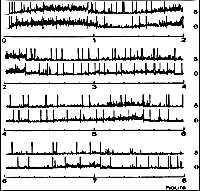 | 3. Studying neurophysiological mechanisms of altered states of consciousness, which are being developed:
- due to some external factors:
- hypoxia
- pharmacological agents
- hypnosis
- due to some internal factors:
- sleep
- dreams
In particular, in the psychiatric hospital of Mainz, in collaboration with German scientists J. Roeschke and J.Fell, A.Ya.Kaplan obtained new data on the micro- and macrostructural organization of EEG during the night sleep.
- A.Kaplan, J.Roeschke, B.Darkhovsky, J.Fell. Macrostructural EEG characterization based on nonparametric change-point segmentation: application to sleep analysis. J. Neurosci Methods. 2001;106(1):81-90. [ PDF ]
up |
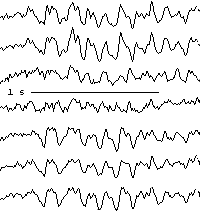 | 4. Studies of activation of hidden mental reserves in autogenic states:
- meditation
- autogenic training
- biofeedback
In collaboration with Prof. G.C.Ray (Indian Institute of Tecnology), A.Ya.Kaplan made several studies of EEG in meditative states. These studies were carried out in ashrams in India, in hereditary yogis highly advanced in meditation.
In collaboration with scientists from Novosibirsk (head: M.B.Shtark, Academician of RAMN), the Human Brain Research Group started the investigations of brain mechanisms underlying the self-control over the functional state in humans, based on self-regulation with the feedback from natural sensory information or from technical tools ("biofeedback").
- E.V.Lobusov, Al.A.Fingelkurts, An.A.Fingelkurts, A.Ya.Kaplan. EEG analysis of deep relaxation states induced by QiGong practice. Vestnik Moskovskogo Universiteta (Bulletin of Moscow University). Ser. 16: Biology. 2001. No 3. P. 36-43. (In Russian) [ PDF ]
- A.Ya.Kaplan. The variability of the heart rhythm and the characteristics of the feedback based on operator activity results in humans. Zh Vyssh Nerv Deiat Im I P Pavlova. 1999 Mar-Apr;49(2):345-350. (In Russian) [ PDF ]
up |
 | 5. The development of adaptogenic pharmacological agents for treating pathological conditions of the brain.
The most important result in this area was the development of the nootropic drug Semax®, under heading by Prof. I.P.Ashmarin, Academician of RAMN and in co-authorship with other colleagues. Semax® is currently widely used in clinical practive in Russia for treating a wide spectrum of brain disorders, from weak ones to severe states such as stroke. The authors were awarded with the State Prise of the Russian Federation Goverment (2001).
- A.Ya.Kaplan, A.G.Kochetova, V.N.Nezavibathko, T.V. Rjasina, I.P.Ashmarin. Synthethic ACTH analogue SEMAX effects on EEG and vigilance performance in human subjects. Neurosci. Res. Communication. 1996;19(2):115-123. [ PDF ]
up |
|
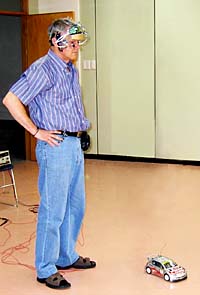
Prof. A.Ya.Kaplan is testing the brain-computer interface, driving a toy car "just by thoughts". Changes in his EEG, associated with mental intentions, are interpreted by a portable computer, which sends commands to the radio control car.
| 6. Creating Intellectual Brain-Computer Interface (Intellectual BCI, IBCI).
Currently, A.Ya.Kaplan, S.L.Shishkin and A.Yu.Zhigalov are developing new algorithms and technical solutions for BCI, with the aim to support faster learned control of the own EEG components. Such algorithms can be implemented for the "thought control" of several parameters in parallel.
About this work in media:
up |
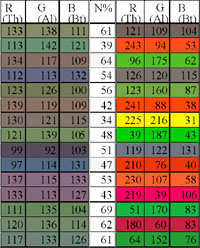 | 7. Studying human ability to change the modes of the activity of own brain networks using unconscious operant conditioning of the EEG patterns.
The ability of human brain to adapt itself for controling, without muscles, technical devices which have EEG input and which provide some feedback, e.g., via monitor (Brain Computer Interface is one type of devices of this kind).
Typically, such adaptation require long period of learning, and still quite many individuals cannot achieve sufficient control. A.Ya.Kaplan et al. (2005), however, provided an experimental evidence that unconscious feedback may strongly facilitate "BCI" learning and make possible to start controlling the machine in a very short time for most subjects.
In this paper, it was also shown that neurofeedback and Brain Computer Interface paradigms, which are usually considered as merely technical applications of EEG, are also a highly efficient tool for basic studies of unconscious processes.
- A.Ya.Kaplan, J.J.Lim, K.S.Jin, B.W.Park, J.G.Byeon, S.U.Tarasova. Unconscious operant conditioning in the paradigm of brain-computer interface based on color perception. Intern. J. Neuroscience. 2005;115:781-802. [ PDF ]
up |
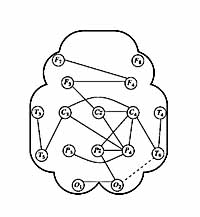 | 8. Objective diagnosis of brain dysfunction in some mental diseases, such as schizophrenia, using new and traditional quantitative EEG indices.
- some objective EEG features most probably related to schizophrenic disorders in adolescents have been identified (Prof. A.Ya.Kaplan, Dr. S.V.Borisov, in collaboration with the experts from Mental Health Research Center: Prof. A.F.Iznak, Dr. N.L.Gorbachevskaya, and others)
- compositions of quantitative EEG indices possibly useful for clinical diagnosis of schizophrenic disorders have been found (Prof. A.Ya.Kaplan, Dr. S.V.Borisov, Dr. V.A.Zheligovsky)
- S.V.Borisov, A.Ya.Kaplan, N.L.Gorbachevskaya, I.A.Kozlova. Analysis of EEG structural synchrony in adolescents with schizophrenic disorders. Human Physiology. 2005;31(3):255-261. (Transl. from Fiziologiya Cheloveka.) [ PDF ]
- A.Ya.Kaplan, S.V.Borisov, V.A.Zheligovsky. Classification of the adolescent EEG by the spectral and segmental characteristics, in normals and in patients with schizophrenic disorders. Zh Vyssh Nerv Deiat Im I P Pavlova. 2005 Jul-Aug;55(4):450-458. (In Russian) [ PDF ]
- S.V.Borisov, A.Ya.Kaplan, N.L.Gorbachevskaya, I.A.Kozlova. Segmental structure of the EEG alpha activity in adolescents with disorders of schizophrenic spectrum. Zh. Vyssh. Nerv. Deiat. Im. I.P.Pavlova. 2005;55(3):329-35. (In Russian) [ PDF ] [ PDF ]
up |
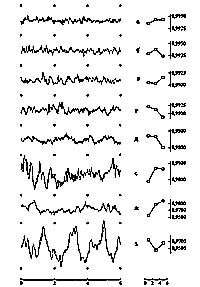 | 9. Designing new heuristic quantitative indexes for the EEG, enabling more fine discrimination of different brain states.
- fundamental complexity of signals (A.Ya.Kaplan, S.L.Shishkin, M.Kosinov (PhD student of the Human Brain Research Group), in collaboration with Prof. B.S.Darkhovsky (RAS Institute for System Ananlysis)
- autocorrelative mobility (in collaboration with Dr. S.F.Timashev and G.V.Vstovsky)
-
B.S.Darkhovsky, A.Ya.Kaplan, S.L.Shishkin. On an approach to the estimation of the complexity of curves, with application to human EEG. Automatica i Telemekhanika (Automation and Remote Control). 2002;3:134-140. (In Russian) Manuscript draft: [ PDF ] Figure: [ GIF ]
up |
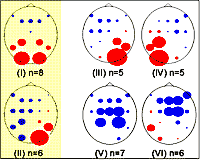 | 10. Extraction and analysis of the EEG components (presumably generated by different sources).
In this area, a number of projects have been or is carried out (by A.Ya.Kaplan, S.V.Borisov, S.L.Shishkin) in collaboration with Prof. E.Oja laboratory (Helsinki University of Technology, Finland), and A.Cichocki laboratory (RIKEN Brain Science Institute, Japan).
- S.L.Shishkin, A.Ya.Kaplan, H.Bakardjian, A.Cichocki. Combining the extremities on the basis of separation: A new approach to EEG/ERP source localization. - Unveiling the Mystery of the Brain: Neurophysiological Investigation of the Brain Function. (Ed. by S. Tsuji et al.). ICS 1278, Elsevier, 2005, pp. 119-122. [ PDF ]
- S.Borisov, A.Ilin, R.Vigario, A.Kaplan. Source localization of low- and high-amplitude alpha activity: A segmental and DSS analysis. Poster presented at Human Brain Mapping 2005 conference. [ PPT ]
up |
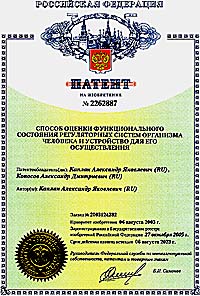 | 11. Developing fast methods for early diagnosis of mental overstrain using indices of autonomic nervous system.
A.Ya.Kaplan has developed:
- the sympato-adrenal tonus index (SAT)
- a new method and device for the diagnosis of mental overstrain in human
SAT is similar to the well-known Bayevsky index, but is more sensitive. The recently developed method of the diagnosis of mental overstrain in human utilies the pulse wave conduction time (RF patent No. 2262887).
- A.Ya.Kaplan. The variability of the heart rhythm and the characteristics of the feedback based on operator activity results in humans. Zh Vyssh Nerv Deiat Im I P Pavlova. 1999 Mar-Apr;49(2):345-350. (In Russian) [ PDF ]
up |
| 12. Designing tests for fast estimating the adaptation of children to school.
This work is a part of the experiment of Moscow City Department of Education. The project principal investigator is Prof. A.Ya.Kaplan. Investigators: S.U.Tarasova (PhD student of the Human Brain Research Group), fellows of Moscow State Social University, Dr. N.N.Yamschikova, and others.
up |
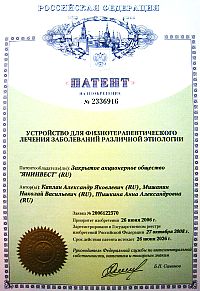 | 13. Study of possible physiotherapeutic application of the EEG based unconscious control of color (computer monitor RGB code) discovered in the laboratory (Kaplan A. 2005 et al).
In particular, we expect that color stimulation currently used in physiotherapy will be significantly improved if the colors will be individually tuned for each person using the brain-computer interface variant developed by A.Ya.Kaplan (see п. 7).
- A.Ya.Kaplan, J.J.Lim, K.S.Jin, B.W.Park, J.G.Byeon, S.U.Tarasova. Unconscious operant conditioning in the paradigm of brain-computer interface based on color perception. Intern. J. Neuroscience. 2005;115:781-802. [ PDF ]
наверх |
Last updated: December 15, 2008.